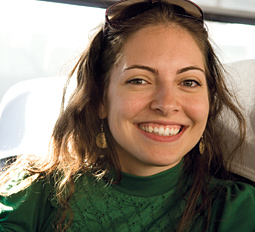Autumn 2007: Cover Story
‘Champions of Peace’
By Reem Marto 03C
Reem Marto 03C is the development and outreach officer for the New York City–based nonprofit organization Soliya, which connects university students in the U.S., Europe, and Middle East through advanced online videoconferencing technology.

Reem Marto 03C
Kay Hinton
My own relationship to the world—as an American, Jordanian, and Palestinian—has been central to my attempts at making sense or nonsense of it all. For me, as for many Palestinians in the diaspora, politics consume the personal. I share with Palestinians across the globe the entanglements of my sense of identity and belonging.
While on the Journeys trip to Israel, Palestine, and Jordan, I felt the hunger of the people living there to share their stories. This was coupled with the eagerness of my fellow American travelers to listen with open minds and to look beyond the stereotypical images of the region frequently offered by Hollywood and the mainstream media.
I graduated with a double major in international and Middle Eastern studies and a minor in Arabic language. During my junior year, I spent a semester in Cairo attending an advanced Arabic language course and a class on Palestinian refugee issues. I pushed myself to ask questions about the conflict and seek different sources of information, and had many conversations about the conflict with both my Arab and American peers. The process of listening, learning, and critiquing that occurred during these oftentimes heated discussions was vital in reconnecting me to my rich Palestinian heritage.
Palestinians are refugees and citizens of many countries. My own large extended family—with more than fifty first cousins—is scattered from Jordan to Jerusalem to Bolivia to the United States. I spent my childhood summers visiting with relatives in Amman, Jordan, where I was born. I enjoyed playing in our garden in front of the old white stone house and awaiting my tete’s—grandmother’s—huge slow-cooked lunches. Each time I return “home” to Amman I find that it has become less and less recognizable. Since the U.S. invasion of Iraq, close to a million Iraqi refugees have joined the developing nation of about five million Jordanians of which, like me, about 70 percent are of Palestinian origin.ÊI notice more than ever the “Westernization” of Amman—with Starbucks cafes and high-rise buildings becoming the norm.
On this journey into the Occupied Palestinian Territories, I crossed over into Israel from Jordan at the Allenby Bridge. Knowing that I was about to enter a completely absurd world, I felt uneasy and anxious at the border crossing. Here, life is dominated by barbed wire and illegal settlements, and is carved into pieces by Israeli military checkpoints and a crippling separation wall. During a previous experience I was questioned and strip-searched before entering. This time, all of my fellow travelers were quickly allowed entry, except for me. Although I also have an American passport, I was asked to wait indefinitely. Four hours went by until I was finally allowed entry by the Israelis into the West Bank—where Palestinians are required to drive with different-colored license plates and carry Israeli-issued ID cards that indicate to which areas, roads, and holy sites they are or are not allowed access. Jewish inhabitants of the West Bank have different ID cards and plates that give them automatic permission to access the modern roads and almost all holy sites.
Despite the deteriorating political and economic conditions imposed by a forty-year crushing military occupation, what I find familiar each time I return is the undiminished will, resolve, and resourcefulness of people. In the face of constant displacement and dispossession, the Palestinians I know are a testament to the resiliency of human beings. I joined my family from Bethlehem at a wedding where everyone celebrated by chatting, dancing to the live music, and enjoying their whiskey on ice. It was a relief to finally relax, laugh, and just enjoy the company. At the wedding I met my father’s tenth-grade teacher, who recounted stories about what Bethlehem was like fifty years ago. I wished I could travel back in time and see my father and his nine brothers and sisters in our old stone house in Jerusalem when there was a rhythm of life that didn’t revolve around fear, checkpoints, and closures.
Throughout the trip we met many thoughtful and compassionate Israeli and Palestinian champions of peace. Just outside Bethlehem, we visited the hundred-acre plot of land owned by the Palestinian Nassar family since 1924. We toured the property teeming with fig trees and grape vines and listened to Daoud Nassar tell his story. From the rocky hilltop we could see that the property was surrounded by Israeli settlements. Through intimidation, violence, and threats, Israelis have been trying to confiscate the Nassar property for years. With the help of other Palestinians and internationals, the Nassars have survived the expensive Israeli court battle thus far and have developed the property into a youth retreat and camping center, the Tent of Nations. I admired his courage and that of all the people we met who are speaking truth to power.
Most of all, I witnessed an amazing capacity for forgiveness and resilience, which gave me a bit of hope for future justice and peace in the region.